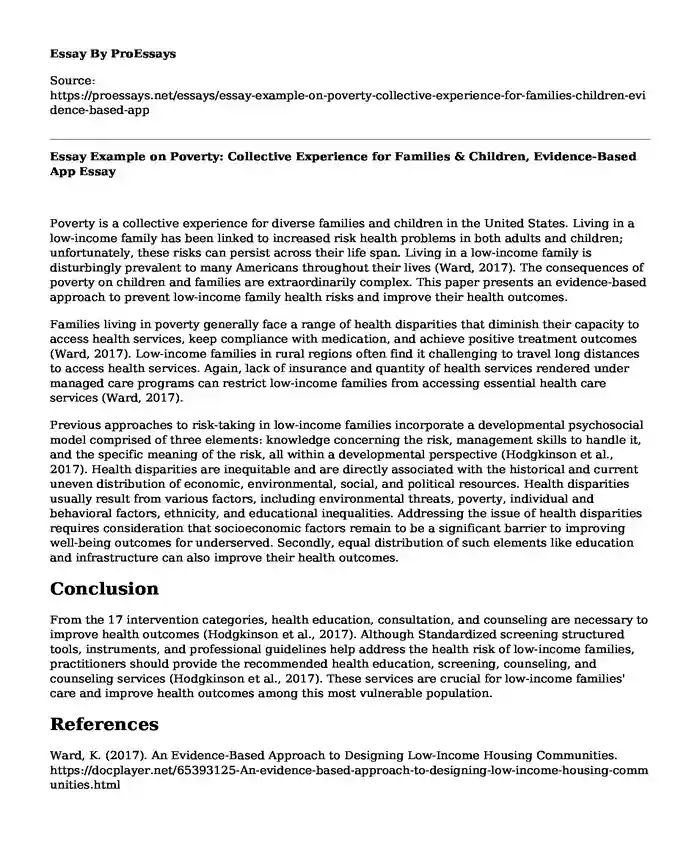Poverty is a collective experience for diverse families and children in the United States. Living in a low-income family has been linked to increased risk health problems in both adults and children; unfortunately, these risks can persist across their life span. Living in a low-income family is disturbingly prevalent to many Americans throughout their lives (Ward, 2017). The consequences of poverty on children and families are extraordinarily complex. This paper presents an evidence-based approach to prevent low-income family health risks and improve their health outcomes.
Families living in poverty generally face a range of health disparities that diminish their capacity to access health services, keep compliance with medication, and achieve positive treatment outcomes (Ward, 2017). Low-income families in rural regions often find it challenging to travel long distances to access health services. Again, lack of insurance and quantity of health services rendered under managed care programs can restrict low-income families from accessing essential health care services (Ward, 2017).
Previous approaches to risk-taking in low-income families incorporate a developmental psychosocial model comprised of three elements: knowledge concerning the risk, management skills to handle it, and the specific meaning of the risk, all within a developmental perspective (Hodgkinson et al., 2017). Health disparities are inequitable and are directly associated with the historical and current uneven distribution of economic, environmental, social, and political resources. Health disparities usually result from various factors, including environmental threats, poverty, individual and behavioral factors, ethnicity, and educational inequalities. Addressing the issue of health disparities requires consideration that socioeconomic factors remain to be a significant barrier to improving well-being outcomes for underserved. Secondly, equal distribution of such elements like education and infrastructure can also improve their health outcomes.
Conclusion
From the 17 intervention categories, health education, consultation, and counseling are necessary to improve health outcomes (Hodgkinson et al., 2017). Although Standardized screening structured tools, instruments, and professional guidelines help address the health risk of low-income families, practitioners should provide the recommended health education, screening, counseling, and counseling services (Hodgkinson et al., 2017). These services are crucial for low-income families' care and improve health outcomes among this most vulnerable population.
References
Ward, K. (2017). An Evidence-Based Approach to Designing Low-Income Housing Communities. https://docplayer.net/65393125-An-evidence-based-approach-to-designing-low-income-housing-communities.html
Hodgkinson, S., Godoy, L., Beers, L. S., & Lewin, A. (2017). Improving mental health access for low-income children and families in the primary care setting. Pediatrics, 139(1), e20151175. 10.1542/peds.2015-1175
Cite this page
Essay Example on Poverty: Collective Experience for Families & Children, Evidence-Based App. (2023, Sep 11). Retrieved from https://proessays.net/essays/essay-example-on-poverty-collective-experience-for-families-children-evidence-based-app
If you are the original author of this essay and no longer wish to have it published on the ProEssays website, please click below to request its removal:
- Matteo Ricci Essay Example
- Essay Sample on Feminism in Art
- Essay Sample on Positive Outcomes of Evidence-Based Care for Patients & Families
- Research Paper on Health Information Systems: Enhancing Quality & Efficiency in Healthcare
- Paper Example on Triage Officers' Ethical Obligations for Efficient Patient Sorting
- Essay Sample on Institutionalized Racism: Generational Crime, Poverty and Disenfranchisement of African-Americans
- Probing Dental Implants: Collecting Critical Info - Essay Sample







